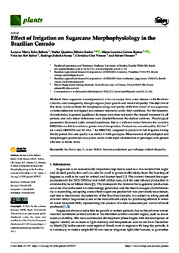Effect of Irrigation on Sugarcane Morphophysiology in the Brazilian Cerrado.
Effect of Irrigation on Sugarcane Morphophysiology in the Brazilian Cerrado.
Author(s): BATISTA, L. M. T.; RIBEIRO JUNIOR, W. Q.; RAMOS, M. L. G.; BUFON, V. B.; SOUSA, R. Z.; VINSON, C. C.; DEUNER, S.
Summary: Since sugarcane is semi-perennial, it has no escape from water stresses in the Brazilian Cerrado, and consequently, drought impacts plant growth and industrial quality. The objective of this study was to evaluate the morphophysiology and quality of the first ratoon of two sugarcane varieties submitted to irrigated and stressed treatments under field conditions. For the biometric characteristics, in general, significant decreases were observed under the stressed reatment for all periods, and only minor differences were detected between the studied cultivars. Physiological parameters decreased under stressed conditions, but to a different extent between the varieties. RB855536 was able to maintain a greater rate of transpiration. Productivity was reduced by 103 t ha?1 for variety RB855536 and 121 t ha?1 for RB867515, compared to plants with full irrigation during the dry period, but cane quality was similar in both genotypes. Measurements of physiological and morphological parameters may prove useful in the rapid identification of genotypes with greater tolerance to abiotic stress.
Publication year: 2024
Types of publication: Journal article
Unit: Embrapa Cerrados
Observation
Some of Embrapa's publications are published as ePub files. To read them, use or download one of the following free software options to your computer or mobile device. Android: Google Play Books; IOS: iBooks; Windows and Linux: Calibre.
Access other publications
Access the Agricultural Research Database (BDPA) to consult Embrapa's full library collection and records.
Visit Embrapa Bookstore to purchase books and other publications sold by Embrapa.

